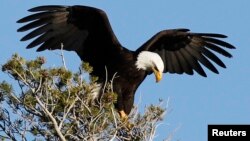U.S. bird populations are in decline across several key habitats, according to the nation's top bird scientists and conservation groups.
Their report - called "The State of the Birds 2014" - identifies so-called arid land birds as the population in steepest decline. These include birds that live in desert habitats in the western United States, which have seen a 46 percent decline in indigenous species since 1968, due primarily to habitat loss and fragmentation. Invasive species are another threat.
The 23-member partnership of government agencies and organizations also reviewed bird populations across grasslands, forests, wetlands, oceans, islands and along the coasts.
Experts also found significant threats in the nation’s grasslands, noting in the report a 40 percent decline in breeding birds, including the eastern meadowlark and the bobolink, since 1968.
But the report notes that conservation efforts have made a significant difference in helping populations recover.
However, there is trouble ahead for North America's birds. A new report from the National Audubon Society warns that more than 300 species are threatened by climate change, including the iconic Bald Eagle.
Researchers analyzed 30 years of North American climate data and thousands of official bird observations over the decades, looking for links between where birds live and climate conditions.
Using predicted scenarios of climate change, they mapped how each bird’s ideal range could shift in the future. A range is the area where birds live and breed, with the temperatures, precipitation, and seasonal changes each species needs to survive.
The study predicts the continent could lose more than 50 percent - and in some cases 100 percent - of the current ranges of 126 species by mid-century because the birds won't be able to relocate to cooler climates.
Their findings indicate, for example, that the current summer range of the eagle - the national symbol of the United States - could decrease by nearly 75 percent in 65 years if temperatures continue to rise at the current pace.
In addition, by 2080, warming temperatures threaten to reduce by half the current ranges of 188 birds, according to the study. However, researchers say it's possible many of these bird species could relocate, recolonizing and making up for the loss, if the proper habitat exists in the new range.
Audubon President David Yarnold calls climate change's impact on birds a "potentially staggering loss.. horrific."
But he says the study creates a road map - and a call to action - to reverse the decline, identifying places where birds live that need protection.
The two reports were issued 100 years after the extinction of the passenger pigeon.










